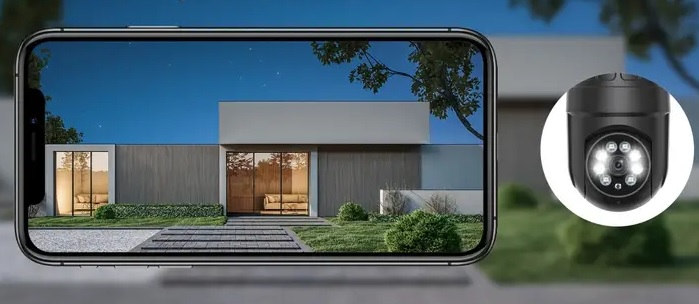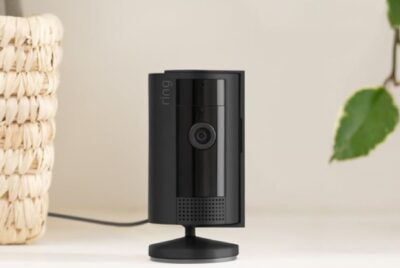Night Vision Security Cameras
Darkness can pose significant security risks, limiting our ability to monitor and protect our properties effectively. Night vision security cameras come to the rescue, providing visibility in low or no-light conditions and helping us keep a watchful eye on our surroundings at all times. Among the various options available, night vision security cameras stood out as an essential component to ensure 24/7 surveillance of my property. In this article, I will guide you through the different types of night vision cameras, their features, and the pros and cons of each, all while keeping the safety of family and property as a top priority.
Understanding Night Vision Technology
Night vision technology has come a long way, providing us with the ability to see in low-light and even pitch-dark conditions. The technology works by amplifying the available light, including infrared light, to create a visible image. There are different generations of night vision technology, with each succeeding generation offering improved performance and image quality.
• Gen 1 Night Vision: The first generation of night vision technology is the most affordable option. It provides a basic level of visibility in the dark but may have limitations in image clarity and range.
• Gen 2 Night Vision: The second generation enhances image brightness and resolution, offering a clearer picture in low-light environments.
• Gen 3 Night Vision: Gen 3 represents a significant advancement in night vision capabilities, providing exceptional image quality and longer detection ranges.
• Thermal Imaging: Unlike traditional night vision, thermal imaging detects heat signatures emitted by objects, animals, or people. It is effective in total darkness and challenging weather conditions.
Types of Night Vision Security Cameras
When choosing night vision security cameras, it’s essential to consider the various types available in the market. Each type caters to different surveillance needs and preferences.
• Bullet Cameras: These are popular, weather-resistant cameras suitable for both indoor and outdoor use. Bullet cameras are easy to mount and offer a fixed viewing angle, making them ideal for monitoring specific areas.
• Dome Cameras: Dome cameras come in compact and discreet designs, making them suitable for indoor installations. They offer a wide viewing angle and are less noticeable, acting as a deterrent to potential intruders.
• PTZ Cameras: PTZ cameras can pan, tilt, and zoom, offering flexible coverage over a wide area. They are remotely controllable, enabling users to focus on specific points of interest.
When selecting the type of camera, consider the surveillance area, aesthetics, and the level of control required.
Wired vs. Wireless Night Vision Cameras
One crucial decision when setting up a night vision camera system is choosing between wired and wireless options. Each has its advantages and disadvantages.
• Wired Night Vision Cameras: Wired cameras require physical connections to power outlets and the recording system. They ensure a stable and continuous power supply, eliminating the need for battery changes. However, the installation process can be more complex and may involve professional assistance.
• Wireless Night Vision Cameras: Wireless cameras offer easy installation and greater flexibility in camera placement. They operate on batteries or rechargeable power sources, reducing the need for extensive wiring. However, batteries require periodic replacement or charging, and wireless signals may encounter interference.
The choice between wired and wireless cameras depends on factors such as the property’s layout, power availability, and personal preferences.
Infrared Illuminators: Built-in vs. External
Infrared illuminators are essential components of night vision cameras, providing the necessary infrared light for visibility in complete darkness. Cameras can either have built-in infrared illuminators or support external ones.
• Built-in Infrared Illuminators: Cameras with built-in infrared illuminators are convenient, as the illuminators are integrated into the camera housing. They offer a compact and discreet design while maintaining effective night vision capabilities.
• External Infrared Illuminators: Some cameras allow external infrared illuminators to be added separately. These illuminators can provide enhanced visibility and extend the camera’s range in complete darkness. They are particularly useful for covering larger outdoor areas.
The choice between built-in and external illuminators depends on the camera model and the specific requirements of your surveillance area.
Image Resolution and Quality
Image resolution plays a crucial role in the quality of night vision camera footage. Higher resolution cameras capture more details, providing clearer and more identifiable images.
• 720p and 1080p Resolutions: Cameras with 720p (HD) and 1080p (Full HD) resolutions are common options for many homeowners. They offer decent image quality and are suitable for general surveillance needs.
• 2K and 4K Resolutions: For higher levels of detail, consider 2K and 4K resolution cameras. These cameras are ideal for scenarios where clear identification of objects or individuals is crucial.
While higher resolutions offer superior image quality, they may also require more significant storage space.
Storage Options
Choosing the right storage option is vital for retaining recorded footage from night vision cameras. Two primary storage options are available:
• Local Storage: This includes using SD cards or network video recorders (NVRs) to store footage locally. SD cards offer simplicity, but their storage capacity is limited. NVRs provide more significant storage capacity and may support multiple cameras.
• Cloud-Based Storage: Cloud-based storage services offer the advantage of remote access to footage and backups in case of camera damage or theft. However, they typically involve monthly subscriptions and may have storage limits.
Select the storage option that aligns with your budget, storage needs, and accessibility preferences.
Integration with Smart Home Systems
In the era of smart homes, integrating night vision cameras with a smart home ecosystem offers added benefits. Compatibility with popular smart home systems allows seamless automation and control.
• Voice Control: Cameras compatible with voice-controlled devices like Amazon Alexa or Google Assistant allow you to control camera settings and view live feeds with simple voice commands.
• Mobile App Integration: Most modern cameras come with dedicated mobile apps, enabling remote monitoring, real-time alerts, and easy camera control on smartphones.
• Home Automation: Integrating night vision cameras with other smart devices, such as smart lights and motion sensors, can create a comprehensive security system that responds to potential threats.
Ensure that the selected camera system is compatible with your existing smart home devices or the smart home system you plan to implement.
Power Source and Backup Options
The power source for night vision cameras affects their reliability and performance. Consider the following power options:
• Battery-Powered Cameras: Battery-powered cameras offer excellent flexibility in camera placement. They are easy to install and operate without the need for extensive wiring. However, regular battery replacement or recharging is essential.
• Wired Cameras with Battery Backup: Some wired cameras include battery backup systems to ensure continuous operation during power outages. These cameras combine the benefits of stable power and backup functionality.
Having a reliable power source is crucial for maintaining uninterrupted surveillance, especially during critical situations.
Factors to Consider when Choosing Night Vision Cameras
Before finalizing your night vision camera system, consider these essential factors:
• Budget: Determine your budget for the camera system and choose options that offer the best value for money.
• Coverage Area: Assess the area you need to monitor and choose cameras with suitable viewing angles and ranges.
• Indoor vs. Outdoor Use: Select cameras specifically designed for indoor or outdoor use based on your surveillance requirements.
• Weather Resistance: If installing outdoor cameras, ensure they are weather-resistant to withstand various weather conditions.
• Night Vision Range: Consider the required night vision range to monitor the desired area effectively.
• Ease of Installation: Evaluate the complexity of installation and decide whether professional assistance is necessary.
• Additional Features: Explore additional features like motion detection, two-way audio, and smart alerts to enhance the camera system’s capabilities.
Setting Up Night Vision Cameras
Setting up night vision cameras can be straightforward if you follow these steps:
1. Assess Surveillance Areas: Identify critical areas for surveillance and plan camera placements accordingly.
2. Install Mounting Brackets: For outdoor cameras, use mounting brackets to secure the cameras in place.
3. Connect Power Source: For wired cameras, connect the power source to ensure continuous operation.
4. Adjust Camera Angles: Adjust the camera angles for optimal coverage and minimize blind spots.
5. Configure Settings: Use the camera’s mobile app or software to configure settings, such as image quality and motion detection.
6. Test Night Vision: Test the night vision capabilities to ensure clear visibility in low-light conditions.
7. Monitor and Adjust: Regularly monitor camera feeds and make adjustments if necessary.
Pros and Cons of Night Vision Security Cameras
Night vision security cameras offer numerous benefits, but they also have some drawbacks. Here’s a summary of their pros and cons:
• Pros:
• 24/7 Surveillance: Night vision cameras provide continuous monitoring even in complete darkness.
• Crime Deterrent: Visible cameras can act as deterrents, reducing the likelihood of break-ins and theft.
• Enhanced Security: Cameras with smart features and integrations offer enhanced security options.
• Remote Monitoring: Many cameras allow remote access to live feeds and footage via mobile apps.
• Peace of Mind: Surveillance cameras offer peace of mind by providing real-time visibility of your property.
• Cons:
• Initial Investment: Night vision camera systems may have higher upfront costs compared to standard cameras.
• Limited Range: The night vision range of cameras may be limited in certain conditions.
• Privacy Concerns: Surveillance cameras can raise privacy concerns for some individuals.
• Power Requirements: Wireless cameras require regular battery maintenance.
Conclusion
Investing in night vision security cameras and systems is a crucial step towards ensuring the safety of your family and home. With various types of cameras available, consider your specific needs and budget to make the right choice. Whether it’s wired or wireless, dome or bullet, each type of camera has its advantages. Additionally, factors like resolution, storage options, and integration with smart home systems can further enhance the capabilities of your surveillance setup. By carefully selecting and setting up night vision cameras, you can have peace of mind knowing that your loved ones and property are protected, day and night.
FAQs
1. What is the difference between night vision and thermal imaging?
Night vision technology amplifies existing light, while thermal imaging detects heat signatures. Night vision is ideal for low-light conditions, while thermal imaging works in total darkness and adverse weather.
2. Can I use night vision cameras outdoors?
Yes, many night vision cameras are designed for outdoor use and can withstand various weather conditions.
3. Are wireless night vision cameras as reliable as wired ones?
Wireless cameras offer flexibility but may be subject to signal interference and require battery maintenance. Wired cameras provide stable power but involve more complex installations.
4. How far can night vision cameras see in complete darkness?
The night vision range varies depending on the camera’s specifications, but it can typically extend from a few yards to several hundred feet.
5. Can night vision cameras be integrated with voice-controlled smart home devices?
Yes, many modern night vision cameras are compatible with voice-controlled smart home devices like Amazon Alexa or Google Assistant, enabling convenient control and monitoring.




